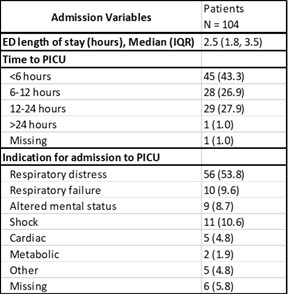Emergency Medicine: All Areas
Category: Abstract Submission
Emergency Medicine IX
379 - Unanticipated PICU transfers of patients admitted from the pediatric ED
Sunday, April 24, 2022
3:30 PM - 6:00 PM US MT
Poster Number: 379
Publication Number: 379.312
Publication Number: 379.312
Allison Adam, Children's Mercy Hospitals and Clinics, Kansas City, MO, United States; Vivek P. Dubey, Children's Mercy Hospital, University of Missouri Kansas City, Kansas City, MO, United States; Shobhit Jain, Children's Mercy Hospitals and Clinics, Kansas City, MO, United States; Jonathan Rodean, Children's Hospital Association, Lenexa, KS, United States

Allison M. Adam, M.D
Chief Resident
Children's Mercy Hospitals and Clinics
Kansas City, Missouri, United States
Presenting Author(s)
Background: In recent years, both locally and nationally, code events occurring outside of the Pediatric Intensive Care Unit (PICU) have declined. However, unanticipated transfers to the PICU remain significant and present a true safety concern. Early escalations of care (within 24 hours of admission) may have associations with patient and clinical factors identifiable while in the ED.
Objective: This study aims to describe the population of patients admitted from the Emergency Department (ED) who were transferred to the PICU within 24 hours of admission and identify patterns in this patient population. It is part of an ongoing study that aims to identify predictive factors for PICU transfers while accounting for variables like seasonality and staffing.
Design/Methods: This study was conducted at a quaternary children’s hospital with 2 EDs - combined volume of 120,000 annual visits with an 11% admission rate. From chart review starting in July 2020, clinical information was gathered for patients admitted to the inpatient wards from the ED who were then transferred to the PICU within 24 hours. The demographic variables and clinical characteristics among this patient cohort were reviewed by a multidisciplinary team. The length of stay in relation to timing of transfer was also studied.
Results: From July 2020 to October 2021 there were 108 events requiring transfer to the PICU, roughly 1.4% of admissions from the ED over that time. Patients under 2 years of age (n=51, 49%), and non-Hispanic white (49.1%) were the majority. Black patients (n=28, 28.7%) were over-represented in rapid PICU transfers compared with the 20.7% in all admitted patients. Respiratory etiology accounted for 67.6% (n=66) of transfers, with combined Rhino/Enterovirus and RSV infection being the largest subgroup (n=47, 43.5%). Most transfers occurred within 12 hours of admission from the ED (73, n=70.2%). Early transfers were associated with a shorter total hospital stay - median (IQR) length of stay was 31.6 hours (22.3, 47.9) for patients transferred within 6 hours, compared with those between 6-12 hours (54.8 (34.9, 78.8)) and 12-24 hours (71.3 (50.1, 129.8)).Conclusion(s): The preliminary data is shared from a local collaborative group comprised of ED, PICU, hospitalists, and transport services. 16 months of data suggest that nearly half of all transfers to the PICU occur in children less than 24 months of age and 63.4% of all unanticipated transfers are due to a respiratory etiology, most commonly RSV and Rhino/Enteroviral infection. This will need to be validated at other institutions and may help determine optimal disposition.
Allison Adam Curriculum VitaeAdam CV.pdf
Admission Variables
Objective: This study aims to describe the population of patients admitted from the Emergency Department (ED) who were transferred to the PICU within 24 hours of admission and identify patterns in this patient population. It is part of an ongoing study that aims to identify predictive factors for PICU transfers while accounting for variables like seasonality and staffing.
Design/Methods: This study was conducted at a quaternary children’s hospital with 2 EDs - combined volume of 120,000 annual visits with an 11% admission rate. From chart review starting in July 2020, clinical information was gathered for patients admitted to the inpatient wards from the ED who were then transferred to the PICU within 24 hours. The demographic variables and clinical characteristics among this patient cohort were reviewed by a multidisciplinary team. The length of stay in relation to timing of transfer was also studied.
Results: From July 2020 to October 2021 there were 108 events requiring transfer to the PICU, roughly 1.4% of admissions from the ED over that time. Patients under 2 years of age (n=51, 49%), and non-Hispanic white (49.1%) were the majority. Black patients (n=28, 28.7%) were over-represented in rapid PICU transfers compared with the 20.7% in all admitted patients. Respiratory etiology accounted for 67.6% (n=66) of transfers, with combined Rhino/Enterovirus and RSV infection being the largest subgroup (n=47, 43.5%). Most transfers occurred within 12 hours of admission from the ED (73, n=70.2%). Early transfers were associated with a shorter total hospital stay - median (IQR) length of stay was 31.6 hours (22.3, 47.9) for patients transferred within 6 hours, compared with those between 6-12 hours (54.8 (34.9, 78.8)) and 12-24 hours (71.3 (50.1, 129.8)).Conclusion(s): The preliminary data is shared from a local collaborative group comprised of ED, PICU, hospitalists, and transport services. 16 months of data suggest that nearly half of all transfers to the PICU occur in children less than 24 months of age and 63.4% of all unanticipated transfers are due to a respiratory etiology, most commonly RSV and Rhino/Enteroviral infection. This will need to be validated at other institutions and may help determine optimal disposition.
Allison Adam Curriculum VitaeAdam CV.pdf
Admission Variables

